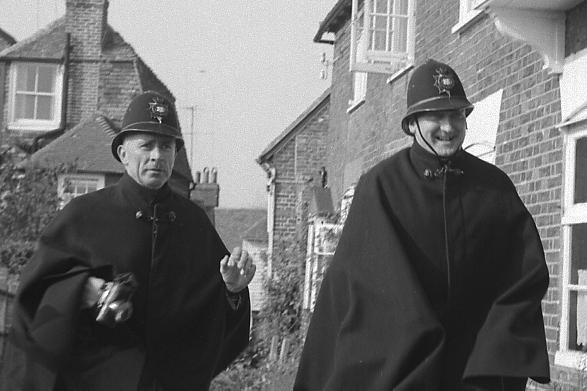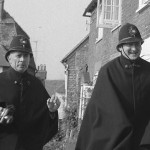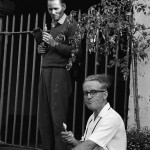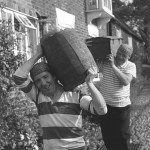The Technicians
Before the days of video cameras and digital equipment which includes sound as an incidental, hours of recording time on a minute electronic chip and computer editing, there was cine film.
By 1960 8mm. film came in colour in 25′ lengths 16mm. wide. It had to be turned over at the two minute point giving a total of four minutes film.
This film, which was usually completed in many 3 to 20 second bursts, then had to be sent to the manufacturers for developing, splitting, splicing together. It arrived back on a small four minute reel. When the film was projected, on a movie projector in a darkened room, the results were surprisingly good if the cameraman had been using the camera as it was meant to be used. The was always a flashing of colours and a bright burst of light as the middle of the film was reached. This was where the light got in as the film was changed over at the two minute point. The brighter the light at the time of changing, the more film lost.
These four minute films were ‘edited’ by the enthusiast. This meant cutting and splicing. Some amateurs were brilliant and their efforts were turned into films that could be enjoyed by a general audience.
Sound was a big problem. There was a system developed by Eumig that allowed a reel to reel tape recorder to be married to a projector and a sound track could be made that would run in synchronisation with the film. This was a complicated method that was soon outdated with magnetic stripe. A firm in Hastings invented a machine that would allow amateurs to stick a thin band of tape along the edge of a cine film. Projectors were already available to project these films because commercial magnetic striped films were already on the market.
There were already several amateur film makers in Rye at the beginning of the 60’s, they banded together and became Rye Movie Society, soon to be know affectionately as The Cine Club.
Meetings were held at the Further Education Centre (The Lion Street School). Fred Masters, Bert Relf, Clive Wall, Roy Miles, Jeffery Waters, Joan Camier, Jim Hollands, Tony Knight, Bert Sanders and Alf Horner were among the early members.
Fred Masters had been making films since the end of the War. He used 16mm as eight was not available until the late fifties. His films were excellent and he shared his experience and technique with the novice members. His shows were viewed with awe as the standard was near professional and to this was added the extra attraction that they were local films of events and places known to most of the members.
Fred’s guidance was one of the great secrets of the ‘cine club’s’ success. Members became good at editing, adding sound, continuity, lighting and all the technical things that make a film watchable.
In the early years of their existence Rye Movie Society won three East Sussex Inter Club Film Competitions in a row against large clubs that had been established for many years. Watching those films again 40 years on I can see why. All three were entertaining, amusing, exciting and well constructed. The technicians work is best seen if its not noticed, the whole interest should be on the content of the film.
The Society held annual Guest Nights where anybody who was anybody were invited. These were entertaining evenings where the best films made by members collectively and individually were screened. The magic of these events was the fact that familiar people and places were found in most of the films selected. There were no ‘holiday films’ included that I can remember.
At the very height of the Society’s popularity at the end of 1965 H.M. Queen Elizabeth and Prince Phillip made an official visit to the town. The Movie Society had cameras everywhere and the resulting colour film that captured not only the Royal Party but almost every person waving and cheering or in the ranks of Air Cadets, Sea Cadets, Scouts, Guides, Brownies, Firemen, Ambulance Service, Police Force, British Legion, Fishermen, Mayor and Councillors in Rye that day, was shown in session after session at the Thomas Peacocke (Grammar School as it was then) until every person that featured in the film, and their families, had seen it.
The Guest night that followed and screened not only the Royal Film but the third and last of their East Sussex award winning films “Further Education” was the very pinnacle of the Cine Club’s success.
The Rye Movie Society continued on into the late 1980’s before it disbanded due to the advent of the video camera. Cine film became outdated and the enthusiasm of the remaining members dwindled away.
No one who was a member or took a part in any of the Club’s movies will forget the fun, sweat and effort it took making them. The Society made about a dozen films in all plus covering many local events. The Society has gone but the films remain, converted to VHS tape to be shown again in future years, a record of Rye and the characters that lived here in the 60’s and 70’s.
From March 2004 “Rye’s Own”




